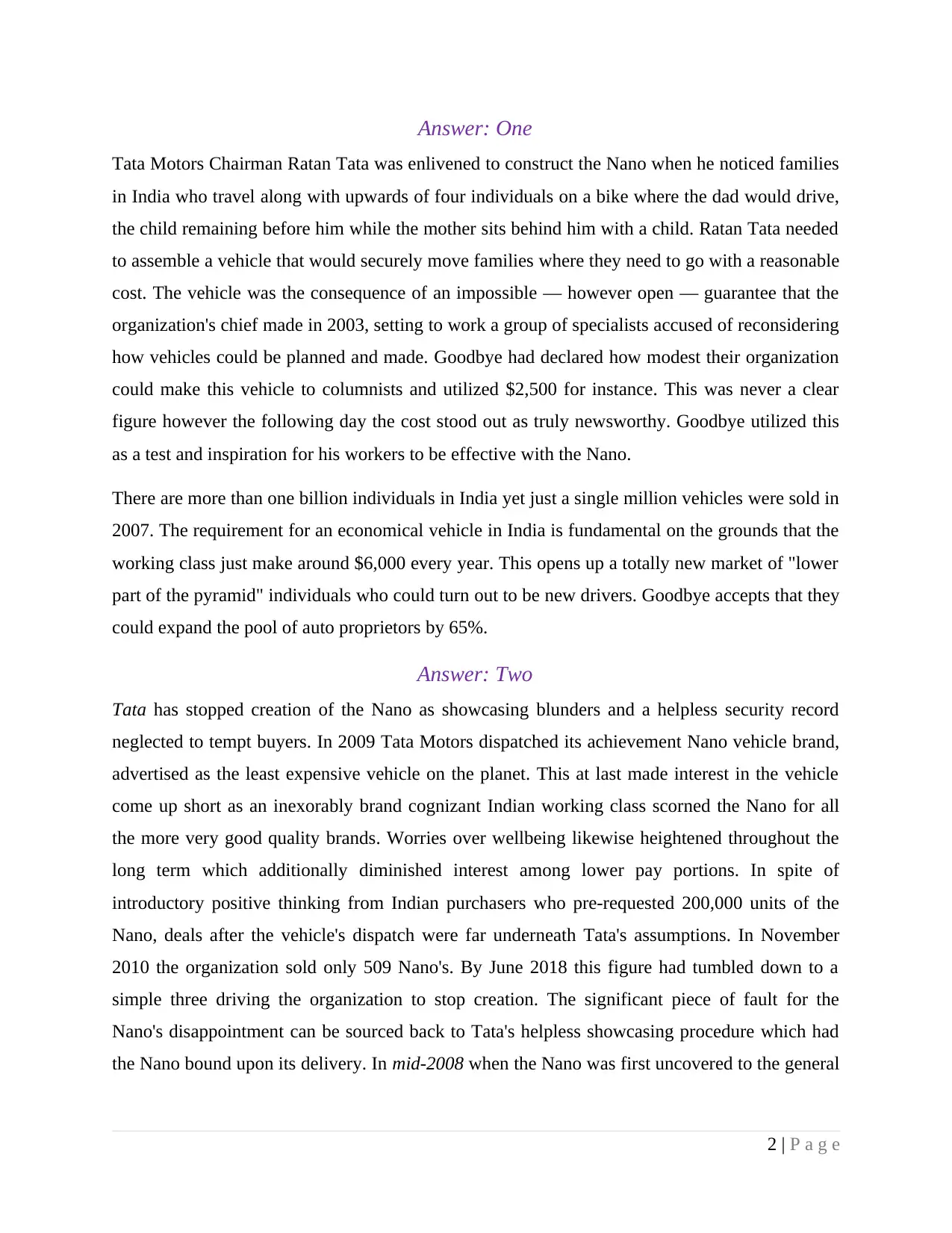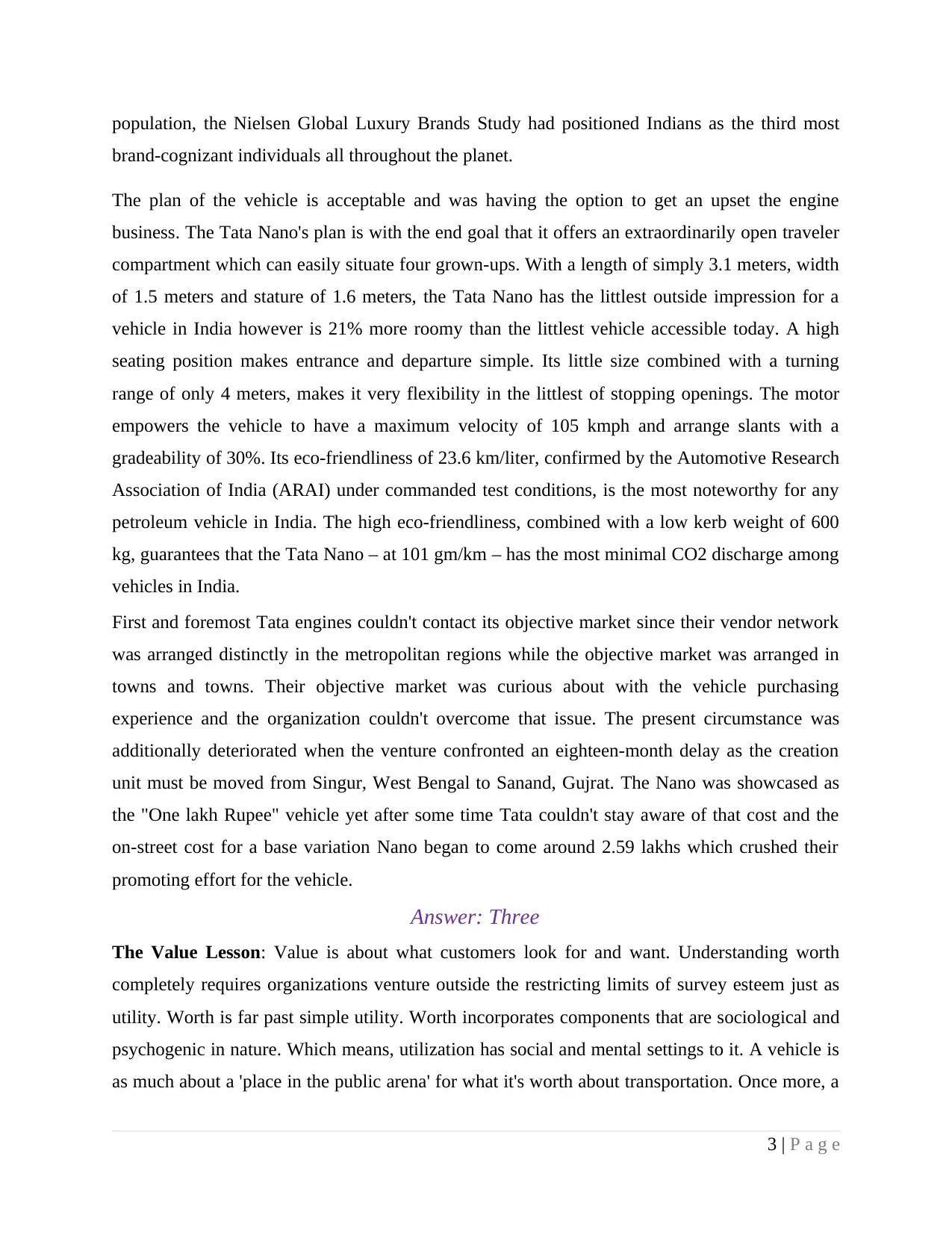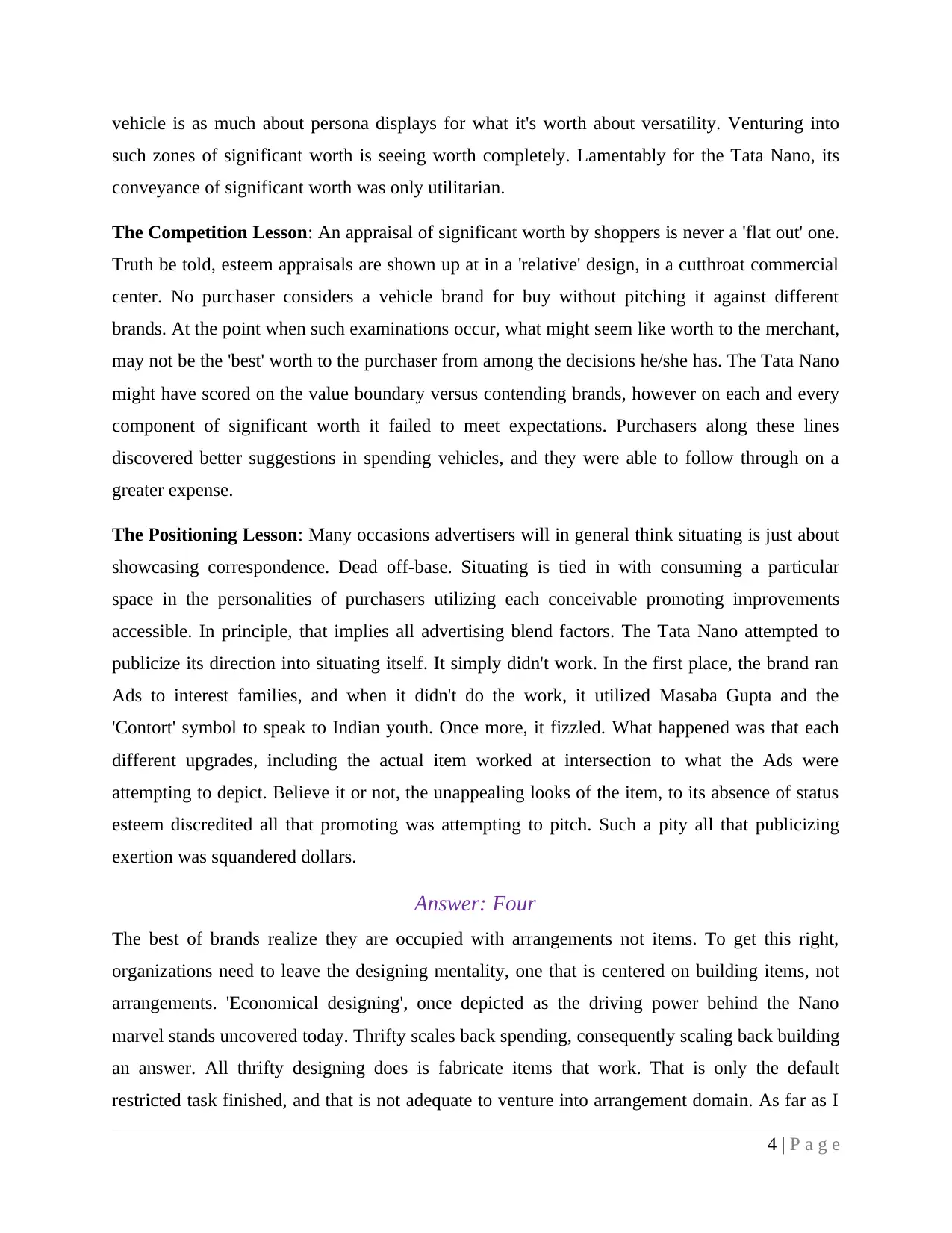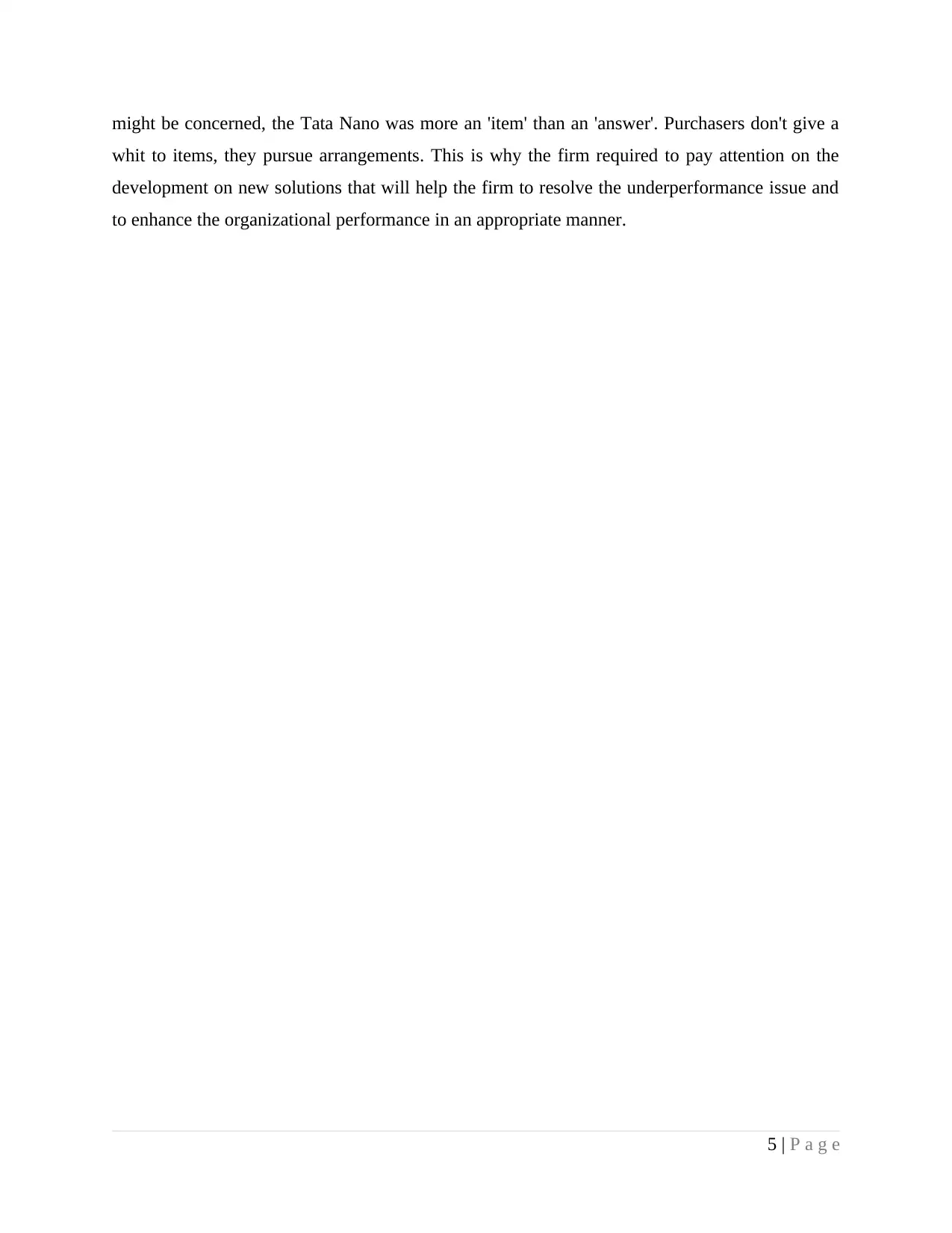Case Study: Tata Nano - Lessons in Business, Marketing, and Strategy
VerifiedAdded on 2021/09/04
|5
|1441
|57
Case Study
AI Summary
This case study examines the Tata Nano, a project initiated by Ratan Tata to provide affordable transportation for Indian families. The assignment analyzes the Nano's design, market positioning, and the factors that contributed to its failure, including marketing blunders, poor safety record, and shifting consumer preferences. The study delves into the concepts of value, competition, and positioning, highlighting how the Nano's utilitarian value proposition failed to resonate with brand-conscious consumers. The case also underscores the importance of understanding the target market's needs and desires, as well as the significance of aligning all marketing elements with the overall brand message. Ultimately, the Tata Nano's failure provides valuable lessons in business strategy, marketing, and the critical need for companies to offer solutions rather than simply products.

Case Study on Tata Nano
1 | P a g e
1 | P a g e
Paraphrase This Document
Need a fresh take? Get an instant paraphrase of this document with our AI Paraphraser

Answer: One
Tata Motors Chairman Ratan Tata was enlivened to construct the Nano when he noticed families
in India who travel along with upwards of four individuals on a bike where the dad would drive,
the child remaining before him while the mother sits behind him with a child. Ratan Tata needed
to assemble a vehicle that would securely move families where they need to go with a reasonable
cost. The vehicle was the consequence of an impossible — however open — guarantee that the
organization's chief made in 2003, setting to work a group of specialists accused of reconsidering
how vehicles could be planned and made. Goodbye had declared how modest their organization
could make this vehicle to columnists and utilized $2,500 for instance. This was never a clear
figure however the following day the cost stood out as truly newsworthy. Goodbye utilized this
as a test and inspiration for his workers to be effective with the Nano.
There are more than one billion individuals in India yet just a single million vehicles were sold in
2007. The requirement for an economical vehicle in India is fundamental on the grounds that the
working class just make around $6,000 every year. This opens up a totally new market of "lower
part of the pyramid" individuals who could turn out to be new drivers. Goodbye accepts that they
could expand the pool of auto proprietors by 65%.
Answer: Two
Tata has stopped creation of the Nano as showcasing blunders and a helpless security record
neglected to tempt buyers. In 2009 Tata Motors dispatched its achievement Nano vehicle brand,
advertised as the least expensive vehicle on the planet. This at last made interest in the vehicle
come up short as an inexorably brand cognizant Indian working class scorned the Nano for all
the more very good quality brands. Worries over wellbeing likewise heightened throughout the
long term which additionally diminished interest among lower pay portions. In spite of
introductory positive thinking from Indian purchasers who pre-requested 200,000 units of the
Nano, deals after the vehicle's dispatch were far underneath Tata's assumptions. In November
2010 the organization sold only 509 Nano's. By June 2018 this figure had tumbled down to a
simple three driving the organization to stop creation. The significant piece of fault for the
Nano's disappointment can be sourced back to Tata's helpless showcasing procedure which had
the Nano bound upon its delivery. In mid-2008 when the Nano was first uncovered to the general
2 | P a g e
Tata Motors Chairman Ratan Tata was enlivened to construct the Nano when he noticed families
in India who travel along with upwards of four individuals on a bike where the dad would drive,
the child remaining before him while the mother sits behind him with a child. Ratan Tata needed
to assemble a vehicle that would securely move families where they need to go with a reasonable
cost. The vehicle was the consequence of an impossible — however open — guarantee that the
organization's chief made in 2003, setting to work a group of specialists accused of reconsidering
how vehicles could be planned and made. Goodbye had declared how modest their organization
could make this vehicle to columnists and utilized $2,500 for instance. This was never a clear
figure however the following day the cost stood out as truly newsworthy. Goodbye utilized this
as a test and inspiration for his workers to be effective with the Nano.
There are more than one billion individuals in India yet just a single million vehicles were sold in
2007. The requirement for an economical vehicle in India is fundamental on the grounds that the
working class just make around $6,000 every year. This opens up a totally new market of "lower
part of the pyramid" individuals who could turn out to be new drivers. Goodbye accepts that they
could expand the pool of auto proprietors by 65%.
Answer: Two
Tata has stopped creation of the Nano as showcasing blunders and a helpless security record
neglected to tempt buyers. In 2009 Tata Motors dispatched its achievement Nano vehicle brand,
advertised as the least expensive vehicle on the planet. This at last made interest in the vehicle
come up short as an inexorably brand cognizant Indian working class scorned the Nano for all
the more very good quality brands. Worries over wellbeing likewise heightened throughout the
long term which additionally diminished interest among lower pay portions. In spite of
introductory positive thinking from Indian purchasers who pre-requested 200,000 units of the
Nano, deals after the vehicle's dispatch were far underneath Tata's assumptions. In November
2010 the organization sold only 509 Nano's. By June 2018 this figure had tumbled down to a
simple three driving the organization to stop creation. The significant piece of fault for the
Nano's disappointment can be sourced back to Tata's helpless showcasing procedure which had
the Nano bound upon its delivery. In mid-2008 when the Nano was first uncovered to the general
2 | P a g e

population, the Nielsen Global Luxury Brands Study had positioned Indians as the third most
brand-cognizant individuals all throughout the planet.
The plan of the vehicle is acceptable and was having the option to get an upset the engine
business. The Tata Nano's plan is with the end goal that it offers an extraordinarily open traveler
compartment which can easily situate four grown-ups. With a length of simply 3.1 meters, width
of 1.5 meters and stature of 1.6 meters, the Tata Nano has the littlest outside impression for a
vehicle in India however is 21% more roomy than the littlest vehicle accessible today. A high
seating position makes entrance and departure simple. Its little size combined with a turning
range of only 4 meters, makes it very flexibility in the littlest of stopping openings. The motor
empowers the vehicle to have a maximum velocity of 105 kmph and arrange slants with a
gradeability of 30%. Its eco-friendliness of 23.6 km/liter, confirmed by the Automotive Research
Association of India (ARAI) under commanded test conditions, is the most noteworthy for any
petroleum vehicle in India. The high eco-friendliness, combined with a low kerb weight of 600
kg, guarantees that the Tata Nano – at 101 gm/km – has the most minimal CO2 discharge among
vehicles in India.
First and foremost Tata engines couldn't contact its objective market since their vendor network
was arranged distinctly in the metropolitan regions while the objective market was arranged in
towns and towns. Their objective market was curious about with the vehicle purchasing
experience and the organization couldn't overcome that issue. The present circumstance was
additionally deteriorated when the venture confronted an eighteen-month delay as the creation
unit must be moved from Singur, West Bengal to Sanand, Gujrat. The Nano was showcased as
the "One lakh Rupee" vehicle yet after some time Tata couldn't stay aware of that cost and the
on-street cost for a base variation Nano began to come around 2.59 lakhs which crushed their
promoting effort for the vehicle.
Answer: Three
The Value Lesson: Value is about what customers look for and want. Understanding worth
completely requires organizations venture outside the restricting limits of survey esteem just as
utility. Worth is far past simple utility. Worth incorporates components that are sociological and
psychogenic in nature. Which means, utilization has social and mental settings to it. A vehicle is
as much about a 'place in the public arena' for what it's worth about transportation. Once more, a
3 | P a g e
brand-cognizant individuals all throughout the planet.
The plan of the vehicle is acceptable and was having the option to get an upset the engine
business. The Tata Nano's plan is with the end goal that it offers an extraordinarily open traveler
compartment which can easily situate four grown-ups. With a length of simply 3.1 meters, width
of 1.5 meters and stature of 1.6 meters, the Tata Nano has the littlest outside impression for a
vehicle in India however is 21% more roomy than the littlest vehicle accessible today. A high
seating position makes entrance and departure simple. Its little size combined with a turning
range of only 4 meters, makes it very flexibility in the littlest of stopping openings. The motor
empowers the vehicle to have a maximum velocity of 105 kmph and arrange slants with a
gradeability of 30%. Its eco-friendliness of 23.6 km/liter, confirmed by the Automotive Research
Association of India (ARAI) under commanded test conditions, is the most noteworthy for any
petroleum vehicle in India. The high eco-friendliness, combined with a low kerb weight of 600
kg, guarantees that the Tata Nano – at 101 gm/km – has the most minimal CO2 discharge among
vehicles in India.
First and foremost Tata engines couldn't contact its objective market since their vendor network
was arranged distinctly in the metropolitan regions while the objective market was arranged in
towns and towns. Their objective market was curious about with the vehicle purchasing
experience and the organization couldn't overcome that issue. The present circumstance was
additionally deteriorated when the venture confronted an eighteen-month delay as the creation
unit must be moved from Singur, West Bengal to Sanand, Gujrat. The Nano was showcased as
the "One lakh Rupee" vehicle yet after some time Tata couldn't stay aware of that cost and the
on-street cost for a base variation Nano began to come around 2.59 lakhs which crushed their
promoting effort for the vehicle.
Answer: Three
The Value Lesson: Value is about what customers look for and want. Understanding worth
completely requires organizations venture outside the restricting limits of survey esteem just as
utility. Worth is far past simple utility. Worth incorporates components that are sociological and
psychogenic in nature. Which means, utilization has social and mental settings to it. A vehicle is
as much about a 'place in the public arena' for what it's worth about transportation. Once more, a
3 | P a g e
⊘ This is a preview!⊘
Do you want full access?
Subscribe today to unlock all pages.

Trusted by 1+ million students worldwide

vehicle is as much about persona displays for what it's worth about versatility. Venturing into
such zones of significant worth is seeing worth completely. Lamentably for the Tata Nano, its
conveyance of significant worth was only utilitarian.
The Competition Lesson: An appraisal of significant worth by shoppers is never a 'flat out' one.
Truth be told, esteem appraisals are shown up at in a 'relative' design, in a cutthroat commercial
center. No purchaser considers a vehicle brand for buy without pitching it against different
brands. At the point when such examinations occur, what might seem like worth to the merchant,
may not be the 'best' worth to the purchaser from among the decisions he/she has. The Tata Nano
might have scored on the value boundary versus contending brands, however on each and every
component of significant worth it failed to meet expectations. Purchasers along these lines
discovered better suggestions in spending vehicles, and they were able to follow through on a
greater expense.
The Positioning Lesson: Many occasions advertisers will in general think situating is just about
showcasing correspondence. Dead off-base. Situating is tied in with consuming a particular
space in the personalities of purchasers utilizing each conceivable promoting improvements
accessible. In principle, that implies all advertising blend factors. The Tata Nano attempted to
publicize its direction into situating itself. It simply didn't work. In the first place, the brand ran
Ads to interest families, and when it didn't do the work, it utilized Masaba Gupta and the
'Contort' symbol to speak to Indian youth. Once more, it fizzled. What happened was that each
different upgrades, including the actual item worked at intersection to what the Ads were
attempting to depict. Believe it or not, the unappealing looks of the item, to its absence of status
esteem discredited all that promoting was attempting to pitch. Such a pity all that publicizing
exertion was squandered dollars.
Answer: Four
The best of brands realize they are occupied with arrangements not items. To get this right,
organizations need to leave the designing mentality, one that is centered on building items, not
arrangements. 'Economical designing', once depicted as the driving power behind the Nano
marvel stands uncovered today. Thrifty scales back spending, consequently scaling back building
an answer. All thrifty designing does is fabricate items that work. That is only the default
restricted task finished, and that is not adequate to venture into arrangement domain. As far as I
4 | P a g e
such zones of significant worth is seeing worth completely. Lamentably for the Tata Nano, its
conveyance of significant worth was only utilitarian.
The Competition Lesson: An appraisal of significant worth by shoppers is never a 'flat out' one.
Truth be told, esteem appraisals are shown up at in a 'relative' design, in a cutthroat commercial
center. No purchaser considers a vehicle brand for buy without pitching it against different
brands. At the point when such examinations occur, what might seem like worth to the merchant,
may not be the 'best' worth to the purchaser from among the decisions he/she has. The Tata Nano
might have scored on the value boundary versus contending brands, however on each and every
component of significant worth it failed to meet expectations. Purchasers along these lines
discovered better suggestions in spending vehicles, and they were able to follow through on a
greater expense.
The Positioning Lesson: Many occasions advertisers will in general think situating is just about
showcasing correspondence. Dead off-base. Situating is tied in with consuming a particular
space in the personalities of purchasers utilizing each conceivable promoting improvements
accessible. In principle, that implies all advertising blend factors. The Tata Nano attempted to
publicize its direction into situating itself. It simply didn't work. In the first place, the brand ran
Ads to interest families, and when it didn't do the work, it utilized Masaba Gupta and the
'Contort' symbol to speak to Indian youth. Once more, it fizzled. What happened was that each
different upgrades, including the actual item worked at intersection to what the Ads were
attempting to depict. Believe it or not, the unappealing looks of the item, to its absence of status
esteem discredited all that promoting was attempting to pitch. Such a pity all that publicizing
exertion was squandered dollars.
Answer: Four
The best of brands realize they are occupied with arrangements not items. To get this right,
organizations need to leave the designing mentality, one that is centered on building items, not
arrangements. 'Economical designing', once depicted as the driving power behind the Nano
marvel stands uncovered today. Thrifty scales back spending, consequently scaling back building
an answer. All thrifty designing does is fabricate items that work. That is only the default
restricted task finished, and that is not adequate to venture into arrangement domain. As far as I
4 | P a g e
Paraphrase This Document
Need a fresh take? Get an instant paraphrase of this document with our AI Paraphraser

might be concerned, the Tata Nano was more an 'item' than an 'answer'. Purchasers don't give a
whit to items, they pursue arrangements. This is why the firm required to pay attention on the
development on new solutions that will help the firm to resolve the underperformance issue and
to enhance the organizational performance in an appropriate manner.
5 | P a g e
whit to items, they pursue arrangements. This is why the firm required to pay attention on the
development on new solutions that will help the firm to resolve the underperformance issue and
to enhance the organizational performance in an appropriate manner.
5 | P a g e
1 out of 5
Your All-in-One AI-Powered Toolkit for Academic Success.
+13062052269
info@desklib.com
Available 24*7 on WhatsApp / Email
![[object Object]](/_next/static/media/star-bottom.7253800d.svg)
Unlock your academic potential
Copyright © 2020–2025 A2Z Services. All Rights Reserved. Developed and managed by ZUCOL.